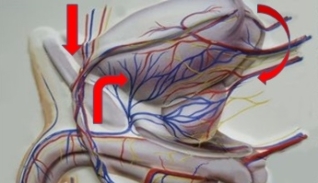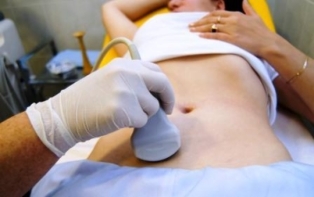Varicose veins of the pelvis or chronic pelvic pain syndrome is still an exotic disease with unclear diagnostic boundaries for many doctors.
This explains the fact that some doctors for a long time not "notice" this disease in the patients, while others got it almost every second person suffers from constant unexplained pain in the abdomen.
Meanwhile, from the early detection varicosity of the pelvic veins is largely dependent on the quality of life of the patient, their ability to enjoy the intimate side of the relationship with the loved one, and the ability to procreate.
The phenomenon of chronic pelvic pain is known to physicians for a long time. But only relatively recently became known the most probable reason is varicose veins of the pelvis. This disease was first described in 1975 and is not yet well known.

The more likely it is that this disease, which evolves according to the following algorithm:
- Plexus venous into the pelvis is a complex construction, which consists of large trunks, vascular, and waste of these small veins. Thus, the venous system of small pelvis in men and women differs according to their structure, which makes the sexual specification of the disease is much more common in the world of sex.
- Because of the compression of the vessels, total or partial obstruction of the venous bed, changes in the tone of the vascular wall impaired exit of the blood from the deep pelvic veins.
- As a result, the veins cease to exercise their functions in full: progression of the insufficiency of the venous valves , and normal outflow of blood.
- In pelvic veins start the congestion associated with the backward reflux of blood through the blood vessels – causes dilation and varicosity development.
The symptoms of varicose veins (varicosity) of the veins of the internal organs of the pelvis is much more common in women of reproductive age than in men. While most suffer from the ovarian vein in 85% of cases.
The main symptom is pain, which is registered in more than 90% of patients. But the prevalence of this disease among the population is still not clear: according to different studies it ranges from 6 to 80%. Such a big difference in the "readings" that can only be explained by the insufficient qualification of medical diagnosticians in the diagnosis.
Causes and risk factors
Causes of pelvic varicosity are the changes in the body that can lead to the implementation of the mechanism of the pathological of the disease:
| Anatomical-physiological cause varicosity | What can cause this |
| Mechanical pressure on the pelvic veins |
|
| The change of tone of the blood vessels |
|
| A blockage of the veins of the pelvis |
|

The increase of risk factors of varicosity of the pelvis are:
- intense physical work;
- not enough regular or unsatisfactory sexual life;
- abuse in intimate life interruption of the sexual relationship;
- a large number of pregnancies and births;
- the most common gynecological diseases;
- contraceptives by means of drugs hormonal;
- hormonal disruptions in the body;
- the lack of exercise.
Classification and stage of varicosity
In medical circles it is accepted conditional division varicosity of the pelvis in the nature of flow in the varicosity of the veins of perineum and external genitalia (e.g., labia minora) and the syndrome of venous plethoras of small pelvis. This classification is of little practical value, since in the majority of cases, patients comply with every one of these forms at the same time, causing the appearance of each one.
You can also find the classification of the disease because of its occurrence. In this sense, the varicosity of the pelvis is divided into:
- primary – caused by the poor performance of the venous valve;
- secondary – develops as a complication of inflammatory diseases, gynaecological or cancer diseases of the internal organs.
There is also an attempt of classification of the disease based on the severity of the disease. In this sense, allocate 3 stages of pelvic varicosity:
| Stage | The characteristic features of the affected veins | |
| diameter (mm) | location | |
| First | less than 5 | any pelvic plexus venous |
| Second | 6 to 10 | the ovaries uterus or |
| Third | 10 more | total defeat of the veins of the pelvis |
What is dangerous, and if the consequences
This pathology vascular can not be called a deadly disease. Discovered in time, it is well medical correction. But the problem is that, in order to detect that it is not so easy. In this play a role and insufficient knowledge of the disease, and the low consciousness of the majority of doctors-diagnosticians.

It turns out that the patients who suffer from this disease, even without knowing it. And in your body, on the other hand, is a series of irreversible changes:
- varicosity progresses, the pathological process included related – there is a dilation of the reproductive organs (for example, varicosity of the penis), perineum, and lower extremities.
- There is a persistent dysfunction of the internal reproductive organs that may cause infertility or the inability to carry pregnancy in women.
- In the midst of the pain syndrome to develop a variety of psychoemotional disorders by type of neurasthenia.
- Because of chronic pain, exacerbated during the privacy, a person can leave completely the sex.
- More rare and at the same time the most serious complications are pelvic varicosity vein thrombosis and thromboembolism pulmonary. That occur in approximately 5% of cases, but always deadly.
Symptoms
Typical symptoms of varicose veins and pelvic vessels that require treatment to the doctor for a treatment include:
- Chronic pain. The pain is most often localized in the lower part of the abdomen, sometimes "give" in the groin and lower back. Accelerate in the second half of the menstrual cycle in women, after intercourse or prolonged standing on his feet.
- Download the treatment of genital. This is typical of "female" symptoms. In this case, select normal in appearance, have no foreign smell. The patient is alarming only their unusually large number.
- External signs of the disease – spider veins or increase in the venous pattern on the thighs, in the crotch area – occurs in approximately half of the patients. Men can experience a small veins in the penis.
- Menstrual disorders in women and disorders of urination in patients of both sexes is rare and evidence of advanced disease.
When you go to the doctor and why?
The reason to go to the doctor can be any of the above symptoms. Procrastinate this is notbecause figuring out the true cause of the discomfort and prescribe an effective treatment will take time.
Profile of the specialist in this disease is the doctor-phlebologist, but for women a first visit to the gynecologist, who will be convinced in the absence of concomitant gynecological diseases.

Diagnosis
According to American researchers, in the beginning 2000-x years only 2% of patients with varicosity of the pelvis, initially, to put the correct diagnosis. Sometimes, the result of errors of diagnosis was the removal of the reproductive organs of women, although this could have been avoided if used the most accurate methods of diagnosis of pelvic varicosity:
- Ultrasound and Doppler study of the veins – allow us to suspect varicosity;
- Phlebography is an invasive study which allows high accuracy to determine the presence and extent of the disease;
- Laparoscopy is indispensable in differential diagnosis of varicosity of small pelvis of similar symptoms of gynecological diseases (endometriosis, fibroids, vaginitis).
- Separate variography is the study of the condition of the veins with contrast agent, is the most objective method of diagnosis.
- Computer or magnetic-resonant tomography allows to define the details of the disease and differentiate it from other pathologies with similar symptoms (joint disease, crohn's disease, etc.).
Treatments
In the treatment of varicosity of the pelvis are the following:
- to normalize vascular tone;
- to improve the nutrition of the tissues;
- avoid the congestion and possible complications.
Treatment of varicosity of the pelvic vessels at a time can go in several directions, while surgical intervention is only necessary in stage 3 of the disease.
| Medical direction | Specific activities |
| Therapy without medication |
|
| Drug therapy |
|
| Surgery |
|
| Treatment of folk ways | using herbs remedia based on dandelion, chagas and chestnut |

Predictions and prevention measures
To completely cure the varicose veins of the pelvis without surgery is almost impossible. With conservative medicine can significantly alleviate and even eliminate most of the unpleasant symptoms and greatly reduce the risk of complications of the disease. The operation also does not give an absolute guarantee that the disease will not return.
In order to avoid the recurrence, you should always comply with own style of life:
- do not smoke;
- don't use hormone medication without a control;
- more moving and less standing on their feet yet;
- in order to comply with the antisclerotic diet with lots of fresh plant foods;
- daily perform complex medical gymnastics and breathing exercises to maintain the health of the blood vessels;
- after performing the surgery on varicosity need to wear compression tights and take preventive doses of prescribed drugs-venotonics.
Pelvic varicosity – this is a hidden beach, women's health, a kind of disease Ghost, which is difficult to detect, but the suffering is very real.
The main symptom of the disease, chronic pelvic pain, which may disturb the patient for a long time and become a source of rejection of the many joys of life. To resist this type of discomfort and not to go to the doctor it is impossible!
With the appearance of specific symptoms should be clearly understood that this is not normal and immediately ask for help to a specialist.




































